 W
WAn oil well is a boring in the Earth that is designed to bring petroleum oil hydrocarbons to the surface. Usually some natural gas is released as associated petroleum gas along with the oil. A well that is designed to produce only gas may be termed a gas well.
 W
WA referendum on oil and natural gas drilling was held in Italy on 17 April 2016. The referendum was on the proposed repealing of a law that allows gas and oil drilling concessions extracting hydrocarbon within 12 nautical miles of the Italian coast to be prolonged until the exhaustion of the useful life of the fields.
 W
WA blowout is the uncontrolled release of crude oil and/or natural gas from an oil well or gas well after pressure control systems have failed. Modern wells have blowout preventers intended to prevent such an occurrence. An accidental spark during a blowout can lead to a catastrophic oil or gas fire.
 W
WA blowout preventer (BOP) is a specialized valve or similar mechanical device, used to seal, control and monitor oil and gas wells to prevent blowouts, the uncontrolled release of crude oil or natural gas from a well. They are usually installed in stacks of other valves.
 W
WThe Brigham Young Oil Well is an oil seep near Evanston, Wyoming that was discovered and used by the original Mormon expedition to Utah under the leadership of Brigham Young. The party used the oil on the surface to lubricate wagon wheel hubs, as polish, and as a poultice. After the party reached Great Salt Lake, a group returned and dug a well at the seep for other pioneers. The well served until 1869 when the Union Pacific Railroad brought petroleum to Salt Lake City.
 W
WThe Bureau of Ocean Energy Management (BOEM) is an agency within the United States Department of the Interior, established in 2010 by Secretarial Order.
 W
WThe Minerals Management Service (MMS) was an agency of the United States Department of the Interior that managed the nation's natural gas, oil and other mineral resources on the outer continental shelf (OCS).
 W
WThe Cameron ram-type blowout preventer was the first successful blowout preventer (BOP) for oil wells. It was developed by James S. Abercrombie and Harry S. Cameron in 1922. The device was issued U.S. Patent 1,569,247 on January 12, 1926. The blowout preventer was designated as a Mechanical Engineering Landmark in 2003.
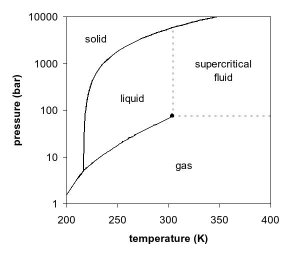 W
WCarbon dioxide (CO2) flooding is a process whereby carbon dioxide is injected into an oil reservoir in order to increase output when extracting oil.
 W
WCasing is a large diameter pipe that is assembled and inserted into a recently drilled section of a borehole. Similar to the bones of a spine protecting the spinal cord, casing is set inside the drilled borehole to protect and support the wellstream. The lower portion is typically held in place with cement. Deeper strings usually are not cemented all the way to the surface, so the weight of the pipe must be partially supported by a casing hanger in the wellhead.
 W
WIn petroleum and natural gas extraction, a Christmas tree, or "tree", is an assembly of valves, casing spools, and fittings used to regulate the flow of pipes in an oil well, gas well, water injection well, water disposal well, gas injection well, condensate well and other types of wells.
 W
WIn the oil and gas industries, coiled tubing refers to a very long metal pipe, normally 1 to 3.25 in in diameter which is supplied spooled on a large reel. It is used for interventions in oil and gas wells and sometimes as production tubing in depleted gas wells. Coiled tubing is often used to carry out operations similar to wirelining. The main benefits over wireline are the ability to pump chemicals through the coil and the ability to push it into the hole rather than relying on gravity. Pumping can be fairly self-contained, almost a closed system, since the tube is continuous instead of jointed pipe. For offshore operations, the 'footprint' for a coiled tubing operation is generally larger than a wireline spread, which can limit the number of installations where coiled tubing can be performed and make the operation more costly. A coiled tubing operation is normally performed through the drilling derrick on the oil platform, which is used to support the surface equipment, although on platforms with no drilling facilities a self-supporting tower can be used instead. For coiled tubing operations on sub-sea wells a mobile offshore drilling unit (MODU) e.g. semi-submersible, drillship etc. has to be utilized to support all the surface equipment and personnel, whereas wireline can be carried out from a smaller and cheaper intervention vessel. Onshore, they can be run using smaller service rigs, and for light operations a mobile self-contained coiled tubing rig can be used.
 W
WCoiled tubing umbilicals are a type of piping used in oil and gas wells.
 W
WWell completion is the process of making a well ready for production after drilling operations. This principally involves preparing the bottom of the hole to the required specifications, running in the production tubing and its associated down hole tools as well as perforating and stimulating as required. Sometimes, the process of running in and cementing the casing is also included. After a well has been drilled, should the drilling fluids be removed, the well would eventually close in upon itself. Casing ensures that this will not happen while also protecting the wellstream from outside incumbents, like water or sand.
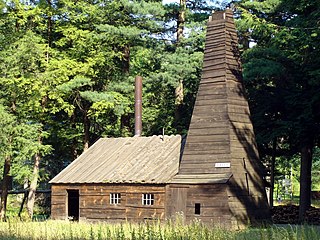 W
WThe Drake Well is a 69.5-foot-deep (21.2 m) oil well in Cherrytree Township, Venango County in the U.S. state of Pennsylvania, the success of which sparked the first oil boom in the United States. The well is the centerpiece of the Drake Well Museum located 3 miles (5 km) south of Titusville.
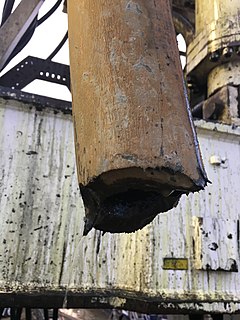 W
WA drill string on a drilling rig is a column, or string, of drill pipe that transmits drilling fluid and torque to the drill bit. The term is loosely applied to the assembled collection of the smuggler pool, drill collars, tools and drill bit. The drill string is hollow so that drilling fluid can be pumped down through it and circulated back up the annulus.
 W
WGA Drilling is a high technology company headquartered in Bratislava (Slovakia) with branches in Bristol (UK), Abu Dhabi (UAE) and Houston (USA). The company was founded in 1994 and rebranded as GA Drilling in August 2013. GA Drilling is developing and commercializing PLASMABIT technology platform which provides drilling tool for challenging the most comprehensive energy industry issues. PLASMABIT is based on high-energy electric plasma enabling to operate at a constant speed with no need for changing tool. PLASMABIT applications are primarily addressed to geothermal energy and mining industries. GA Drilling is also active within drilling community through participation at several industry events.
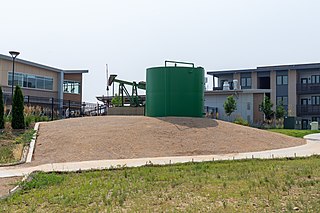 W
WThe McKenzie Well is an oil well site in Boulder, Colorado. The Boulder Oil Field was discovered on this site in 1901, making it the oldest oil-producing site in the entire Denver Basin, and one of the oldest in the western United States. The first producing well on the site was drilled in 1902. Peak production at 85,000 barrels was reached in 1909.
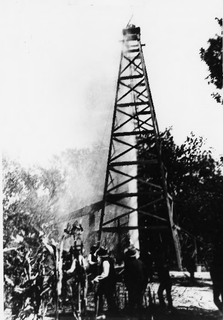 W
WNorman No. 1 Oil Well Site is the site of an abandoned oil well, located at the northeast corner of Mill and First Streets in Neodesha, Kansas, USA. The well, which was drilled on November 28, 1892, was the first successful well in what is now known as the Mid-Continent oil field, kicking off a major oil boom in states from Kansas to Texas and Louisiana. The well site, now a small municipal park, was designated a National Historic Landmark in 1977.
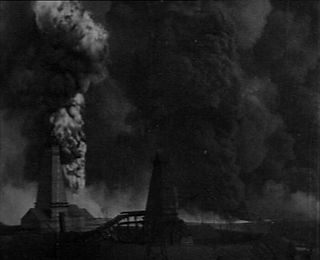 W
WThe Oil Gush Fire in Bibiheybat is an 1898 Azerbaijani silent film. Directed by the pioneer of cinema in Azerbaijan, Alexandre Michon, this 30-second film was shot on August 6, 1898 in Bibiheybət village near Baku and presented at the International Paris Exhibition.
 W
WThe Oil Gush in Balakhany is a film directed by the pioneer of cinema in Azerbaijan, Alexandre Michon, it was filmed on August 4, 1898 in Balakhany, Baku and presented at the International Paris Exhibition. The film was shot using a 35mm film on a Lumière cinematograph.
 W
WThough different jurisdictions have varying criteria for what exactly qualifies as an abandoned oil well, generally speaking an oil well is considered abandoned when it has been permanently taken out of production. Similarly, orphaned wells may have different legal definitions across different jurisdictions, but can be thought of as wells whose legal owner it is not possible to determine. State legislatures in the United States have specific definitions based on local needs and priorities. For example, the section on abandoned wells in Texas' Natural Resource Code defines an "inactive well" as "an unplugged well that has had no reported production, disposal, injection, or other permitted activity for a period of greater than 12 months." Pennsylvania's definition of abandoned well includes not producing for 12 months, "considered dry and not equipped for production within 60 days after drilling, redrilling or deepening, and from which the equipment needed to extract resources or produce energy has been removed." Ohio legislation defines "idle and orphaned wells" based on whether or not a well bond has been forfeited or the money to plug it is unavailable. It defines a "temporary inactive well status" as not having produced for two or eight statutorily defined reporting periods or one that has produced "less than 100,000 cubic feet of natural gas or 15 barrels of crude oil."
 W
WSee snubber for a device used to suppress ("snub") voltage transients in electrical systems
 W
WA submersible pump is a device which has a hermetically sealed motor close-coupled to the pump body. The whole assembly is submerged in the fluid to be pumped. The main advantage of this type of pump is that it prevents pump cavitation, a problem associated with a high elevation difference between pump and the fluid surface. Submersible pumps push fluid to the surface as opposed to jet pumps which create a vacuum and rely upon atmospheric pressure. Submersibles use pressurised fluid from the surface to drive a hydraulic motor downhole, rather than an electric motor, and are used in heavy oil applications with heated water as the motive fluid.
 W
WSubsea Production Systems are typical wells located on the seabed, shallow or deep water. Generally termed as Floating production system, where the petroleum is extracted at the seabed and the same can be tied back to an already existing production platform or an onshore facility. The oil platform well is drilled by a movable rig and the extracted oil or natural gas is transported by submarine pipeline under the sea and then to rise to a processing facility. It is classified intoSubsea production control system Subsea structures and manifold system Subsea intervention system Subsea umbilical system Subsea processing system
 W
WThe Thorla-McKee Well in Noble County, Ohio was the first oil-producing well in North America according to the Ohio Historical Society.
 W
WThe THUMS Islands or Astronaut Islands are a set of four artificial islands in San Pedro Bay off the coast of Long Beach, California.
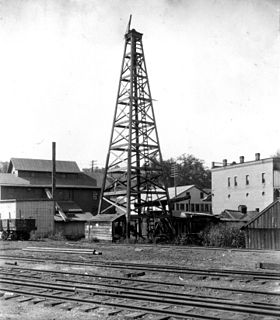 W
WThe Washington oil field is an oil field and in Washington County, Pennsylvania. It also produced natural gas.
 W
WA well intervention, or well work, is any operation carried out on an oil or gas well during, or at the end of, its productive life that alters the state of the well or well geometry, provides well diagnostics, or manages the production of the well.
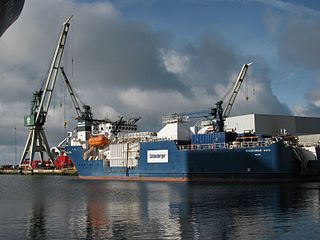 W
WWell stimulation is a well intervention performed on an oil or gas well to increase production by improving the flow of hydrocarbons from the reservoir into the well bore. It may be done using a well stimulator structure or using off shore ships / drilling vessels, also known as "Well stimulation vessels".
 W
WA wellhead is the component at the surface of an oil or gas well that provides the structural and pressure-containing interface for the drilling and production equipment.
 W
WIn the oil and gas industry, the term wireline usually refers to the use of multi-conductor, single conductor or slickline cable, or "wireline", as a conveyance for the acquisition of subsurface petrophysical and geophysical data and the delivery of well construction services such as pipe recovery, perforating, plug setting and well cleaning and fishing. The subsurface geophysical and petrophysical information results in the description and analysis of subsurface geology, reservoir properties and production characteristics.
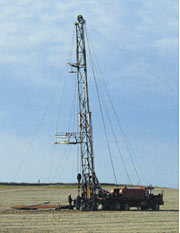 W
WThe term workover is used to refer to any kind of oil well intervention involving invasive techniques, such as wireline, coiled tubing or snubbing. More specifically, a workover refers to the expensive process of pulling and replacing completion or production hardware in order to extend the life of the well.